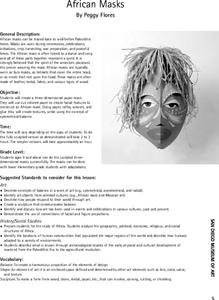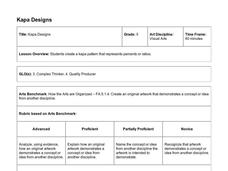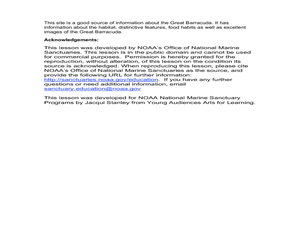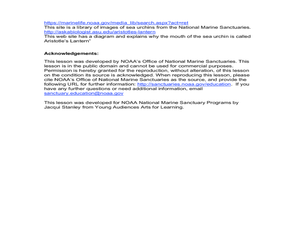Curated OER
Balance
Students distinguish between symmetrical (formal) and asymmetrical (informal) balance. They create a black and white picture which displays both symmetrical balance and asymmetrical balance.
Curated OER
African Masks
Fourth graders create three-dimensional paper African masks. They analyze the geographic, political, economic, religious, and social structures of Africa. they discover that masks were worn for various ceremonies.
Hawaiʻi State Department of Education
Kapa Designs
I always knew there was a connection between art and math, and this lesson proves it. Fifth graders will use what they know about ratios and percents to design art inspired by Polynesian kapa cloth. A grid, specific guidelines, and the...
Code.org
Practice Performance Task - Security and Hacking in the Real World
Young computer scientists create a visual artifact that represents their research into a computing innovation in the world of cybersecurity. They then work individually to write an essay on the impact of technology on cybersecurity.
Dick Blick Art Materials
“Rhythm in Layers”
Young artists learn to build rhythm into a design by repeating colors, shapes, and patterns in a 3-D sculpture activity.
Curated OER
A Different Point of View
Fourth graders imagine what North Carolina looks like from the air. Looking at a map, they list the different kinds of views we might find, (i.e., beach, mountains, cities, farms, etc.) then attempt to draw their own version of a map.
Curated OER
Artwork of World Cultures
Seventh graders research a culture and art produced by the people of that culture. They create a PowerPoint presentation to explain their findings. Students make a sand painting depicting the art of that era.
Curated OER
Patterns & Balance
High schoolers compare and contrast the difference in the two sets of images and discuss the visual interest in the first set and the different visual interest created in the second set of prints.
Curated OER
Baked Polymer Clay 3D People Portraits
Students discuss methods of building forms with clay (ball and variations, snake, flat sheets). They draw a stick figure of what their sculpture may look like, including correct figure proportion.
Curated OER
Elements and Principles Using a Movie
Young scholars identify the elements and principles that appear in an illustration of a room and explain each concept in writing. They watch this movie identifying each of the elements and principles of design portrayed in the interiors...
Curated OER
The Great Barracuda
Students explore oceanography by researching the great barracuda. In this animal life lesson, students read several vocabulary terms dealing with ocean life and examine a drawing of a barracuda. Students examine the many...
Curated OER
Staghorn Coral
Students recognize that staghorn coral helps reef growth in the Caribbean. In this Coral Reef lesson, students design a habitat model using various art materials to explain how staghorn coral helps the reef grow. Students share...
Curated OER
How Japanese Prints Influenced French Artists
Students analyze the influence of Japanese art on French art between 1860 and 1910 in this ideal lesson for the high school Social Studies, Humanties, or Asian Studies classroom. Research itechniques are emphasized.
Curated OER
Wycinanki and Polish Folktales
Students, with the use of the Internet among various other resources, research/locate Polish folktales and re-tell the Polish folktales in their own words. In addition, they examine the art of Wycinanki, Polish paper cutting.
Curated OER
Recognizing Polar Molecules
In this polar molecules worksheet, learners complete a graphic organizer by writing in the bond type, electron dot diagram, and the type of compound for the chemical compounds given.
Curated OER
Body Plans and Adaptations
For this body plans and adaptations worksheet, students will review the different types of symmetry found in organisms. Students will identify body parts as found on either the ventral or dorsal part of an animal. Then students will look...
Curated OER
African Masks
Students make replicas of African masks. They also express what attributes they would want to have as an adult and put that into their mask.
Curated OER
Math is Beautiful
Students explore how geometry is used on the composition of artworks by artists from different cultures. This activity is equally suited for a Math or Art classroom at the late-elementary or early-middle school level.
Curated OER
At Play with Applique
Students apply an applique after learning about the process. Students accurately baste the appliques to the background fabric and hold them securely during the needle turn process.
Curated OER
The Giant Barrel Sponge
Learners study barrel sponges. In this science and art lesson, students discuss what sponges are, create their own sponge, and share what they created with the rest of the class.
Curated OER
The Cleaning Station
Students study cleaning stations. For this science lesson, students make a painting of a fish known as cleaners which take dead skin off of other fish.
Curated OER
Watercolor Paintings O'Keefe Style
Pupils practice watercolor techniques and then apply that knowledge to a painting that uses subject matter and abstracts that Georgia O'Keeffe might have chosen.
Curated OER
Sea Urchins - Diadema Antillarum
Students investigate oceanography by painting sea life. In this crustacean lesson, students identify sea urchins in our ocean environments and describe the functionality of their spherical-shaped bodies. Students design their own sea...
Minneapolis Institute of Arts
Arts Connect Ed Artist's Toolkit: Balance
An interactive site that explores the elements and principles of visual art through the artist's toolkit. This lesson is on balance (symmetrical and asymmetrical) using "Wrist Guard" by Navajo. The animation shows the arrangement of the...























